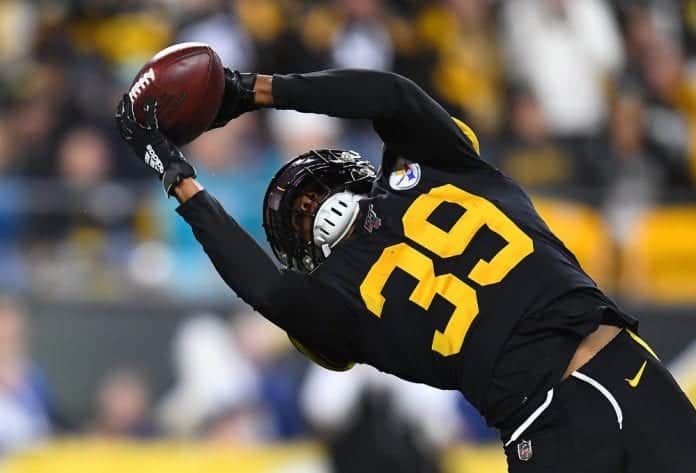Minkah Fitzpatrick is a generational talent. Very few will deny that. But if you ask Nick Saban, his coach at the University of Alabama, it’s Fitzpatrick’s psyche, discipline, preparation and work ethic that defines him. It was his talent, coupled with Saban’s praise, that had many believing Fitzpatrick would be selected in the top ten, possibly even top five, of the 2018 NFL Draft. He ended up being drafted 11th overall by the Miami Dolphins, as a few quarterback-starved franchises passed on him in order to secure their offensive futures. So, how did Minkah Fitzpatrick become a safety for the Pittsburgh Steelers? And, what impact has he made since he’s arrived?
A short stint in South Beach
Ecstatic that he fell to the Dolphins, Fitzpatrick quickly became a fan favorite in Miami. He was known to be a “swiss army knife” that could play every position in the secondary. Due to his versatility, some long-time Dolphins fans likened him to a defensive version of Jim “Crash” Jensen, a hybrid skill position player from the early years of the Dan Marino era. After the 2018 season, however, the front office made some major changes, moving on from many long-time veterans as well as a complete turnover of the coaching staff. As was the case with many who remained on the Dolphins roster, Minkah’s role would become different.
Have you ever tried to fit a marshmallow through a keyhole? Or, build a house with only a swiss army knife? Both can probably be done, but neither are productive nor efficient. That’s what it was like for Minkah in Miami. Albeit a talented player that can do many things, Fitzpatrick was being asked to contribute in ways that didn’t fit his strengths. As a result, he struggled and his weaknesses were exposed in Miami’s secondary.
Time for a change
Shortly after an embarrassing shutout loss to the New England Patriots in Week 2, Miami fielded calls from the Pittsburgh Steelers, who were in desperate need of help in the secondary. Considering the rebuild, and the trades Miami had made leading up to the start of the 2019 season, it was not surprising that Miami was willing to part ways with a veteran defensive back. Rumors swirled that star safety Reshad Jones was being shopped, but Steelers’ coach Mike Tomlin really wanted Fitzpatrick. The Steelers willingly gave up their 2020 1st round pick to get him. Fitzpatrick also wanted a change and embraced this new opportunity with a new team.
Never having a dedicated position in Miami, Minkah was slotted in at free safety in the Steelers defense. Free safeties watch the play unfold, focus on the backfield and react accordingly. Usually smaller in size than strong safeties, free safeties defend the pass first and run second. With many NFL franchises now seeking dual-threat quarterbacks, the value of a free safety has been on the rise.
Ground control
Pittsburgh has always had a solid run defense. You’d have to go back to 2013 to find a Pittsburgh run defense that wasn’t in the top half of the league in yardage allowed. The Steelers run defense was extremely productive in Week 1 against the New England Patriots, holding Sony Michel to less yards (14) than attempts (15), resulting in a Offensive Share Metric (PFN OSM) grade of -10.84, a proprietary grading system of Pro Football Network.
In Week 2, the Steelers defense slipped some, allowing 122 yards on the ground between Chris Carson and Rashaad Penny (Seattle Seahawks), but it was still better than the average PFN OSM for running backs.
Since then, and after Fitzpatrick joined the team in Week 3, opposing player PFN OSM’s have never reached the league average. The Steeler’s run defense has only improved as PFN OSM grades have continued a downward trend throughout the season. Minkah’s presence in the secondary has allowed the defensive line to continue to control the line of scrimmage in a dominant fashion.
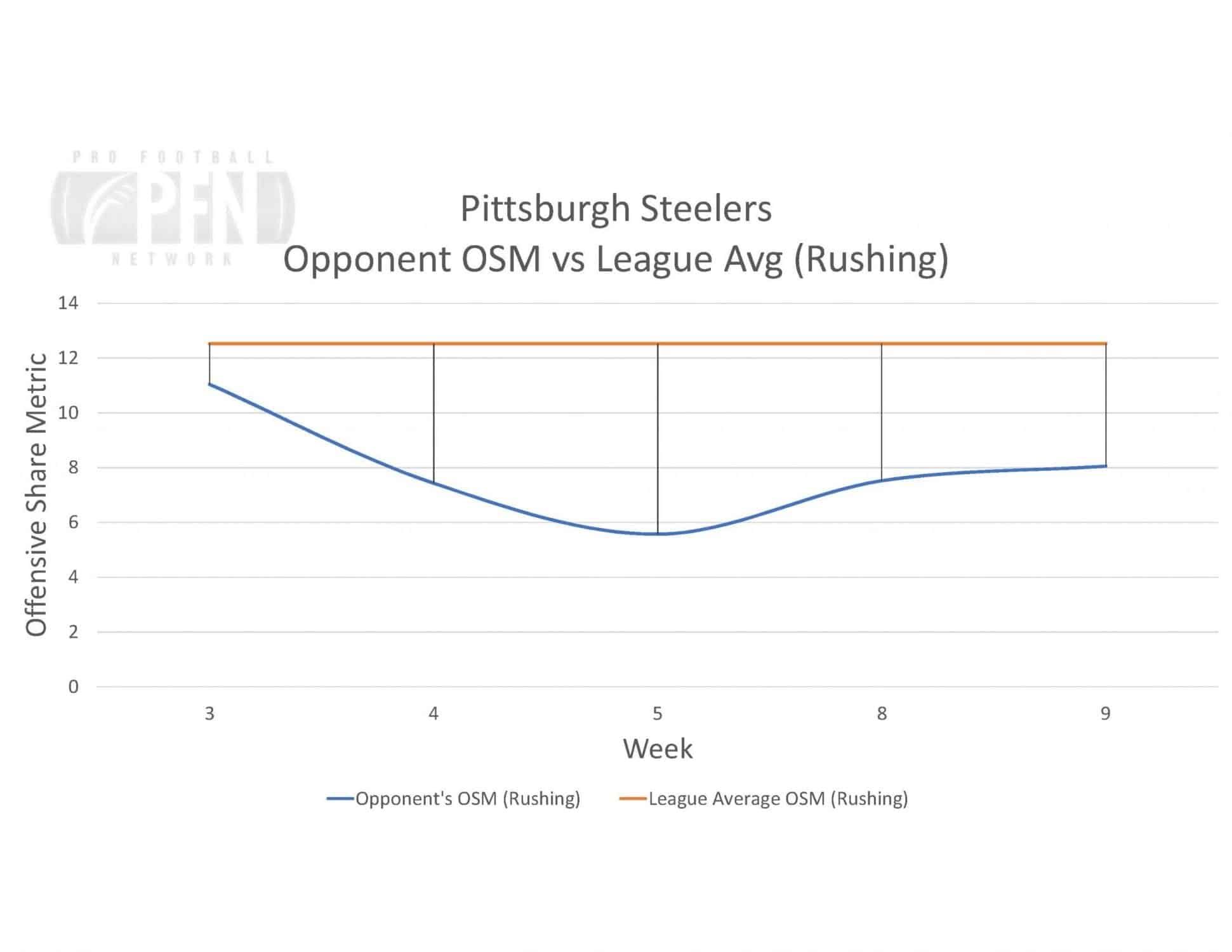
Rushing efficiency is the average distance a running back travels to gain one yard from scrimmage. The lower the number, the better. Interestingly, running back efficiency against the Steelers has improved over time, especially since Week 5. What’s fascinating about this, is it means opposing teams are more apt to attack the line of scrimmage than run outside the tackles.
We can’t credit Fitzpatrick for being the reason teams are doing this but, on the surface, it appears opponents feel they’ll be more successful running up the middle than towards the outside where defenders, including free safeties like Fitzpatrick, would have an opportunity to make a play. At the very least, it implies the Steelers linebackers are not being relied upon as much now as they had been in pass defense, allowing them to focus more on run defense and quarterback pressures.
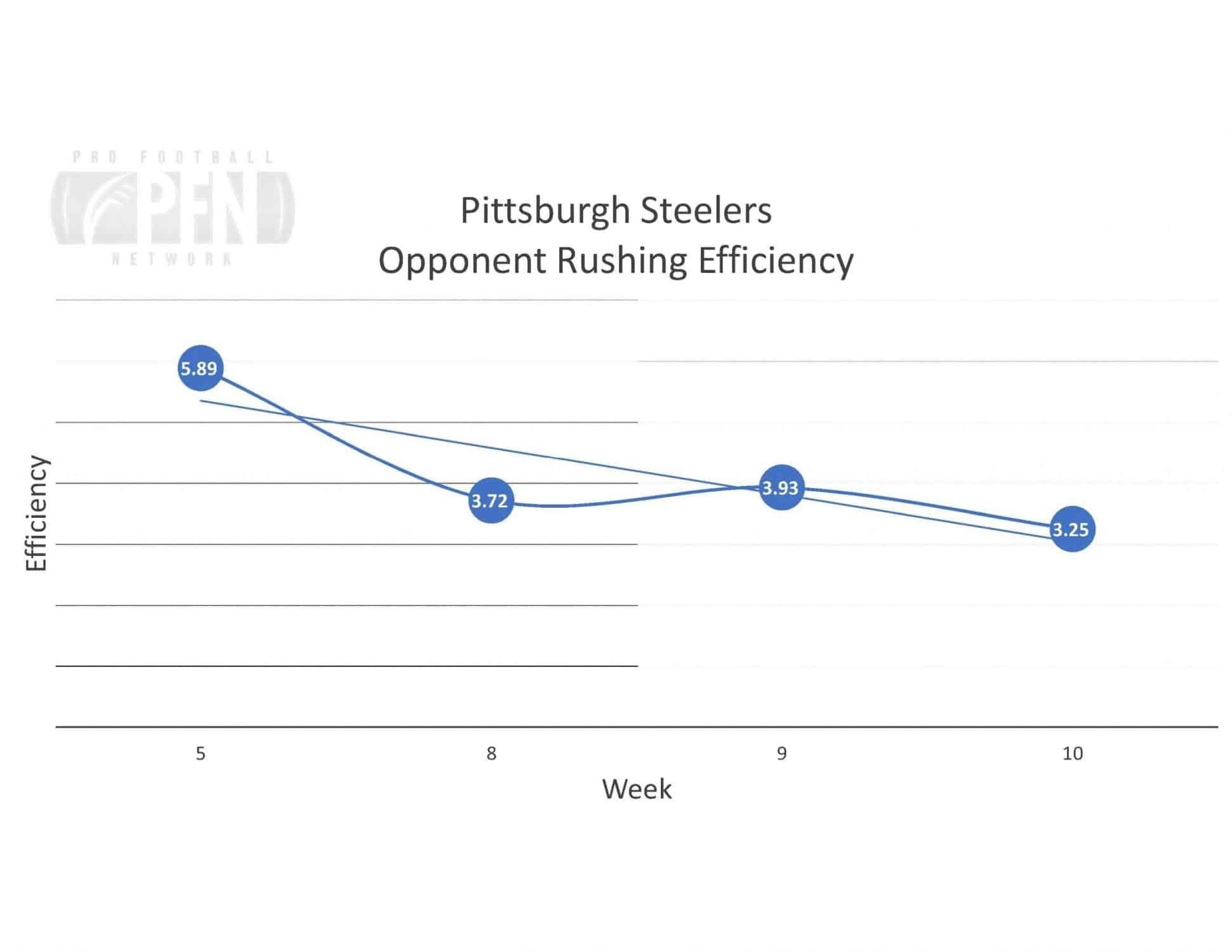 Stopping the air attack
Stopping the air attack
In the passing game, Steelers defenders are giving receivers nearly two more yards of cushion since Minkah came over via trade, compared to the first two weeks of the season. Also, since Week 2, the Steelers have not allowed a team’s receivers to obtain more yards after the catch than expected. The secondary is making the open field tackles they need to make, while not allowing receivers to get behind them or break free for large gains.
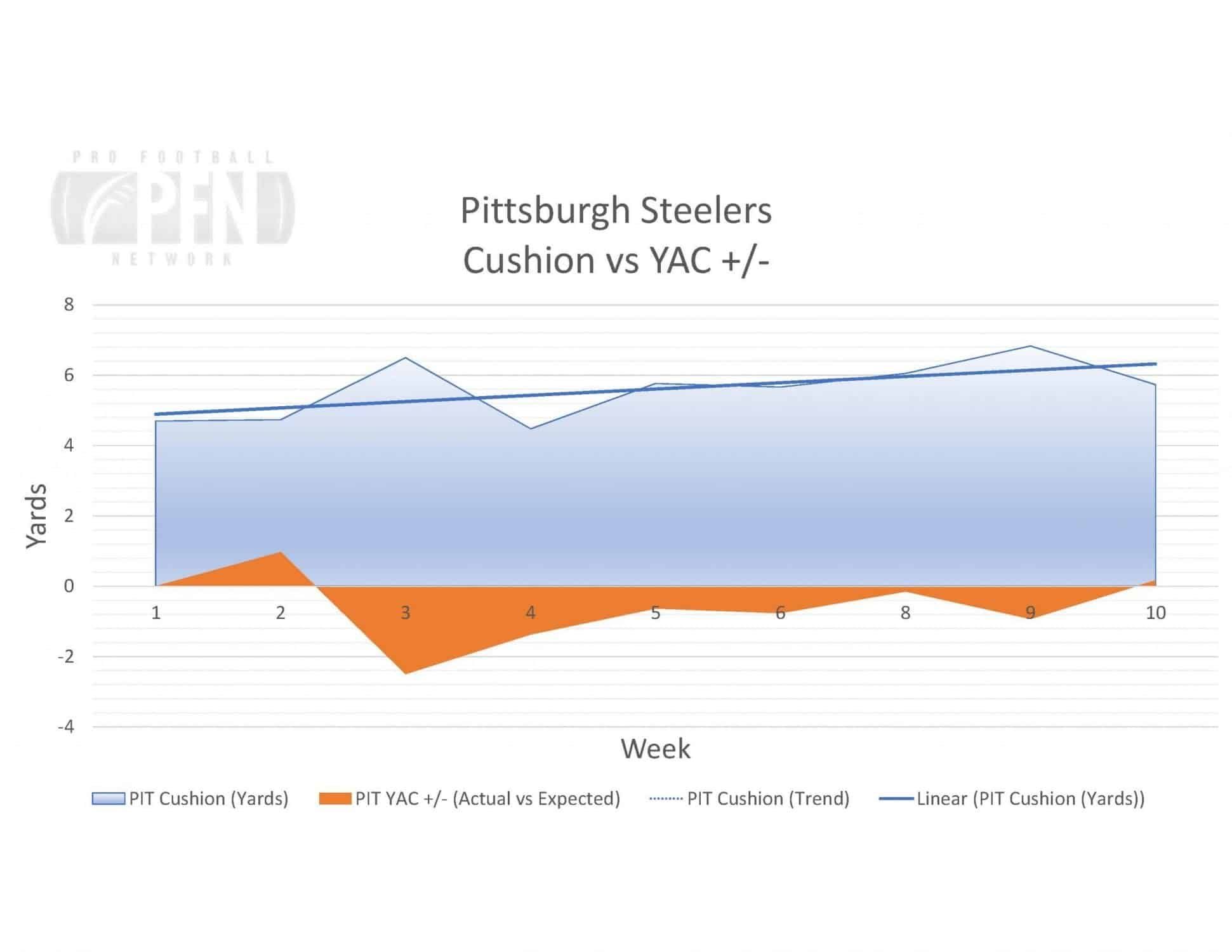 It’s hard to deny Minkah’s impact on the Steelers’ defense and against opposing offenses. Consider a few numbers that even casual fans would be familiar with, passing touchdowns and interceptions. Prior to Fitzpatrick joining the team, the Steelers had allowed six touchdowns through the air and had zero interceptions. After Minkah’s arrival, PFN OSM-qualifying quarterbacks have thrown a total of nine touchdowns over seven games while giving up an incredible thirteen interceptions (almost two per game).
It’s hard to deny Minkah’s impact on the Steelers’ defense and against opposing offenses. Consider a few numbers that even casual fans would be familiar with, passing touchdowns and interceptions. Prior to Fitzpatrick joining the team, the Steelers had allowed six touchdowns through the air and had zero interceptions. After Minkah’s arrival, PFN OSM-qualifying quarterbacks have thrown a total of nine touchdowns over seven games while giving up an incredible thirteen interceptions (almost two per game).
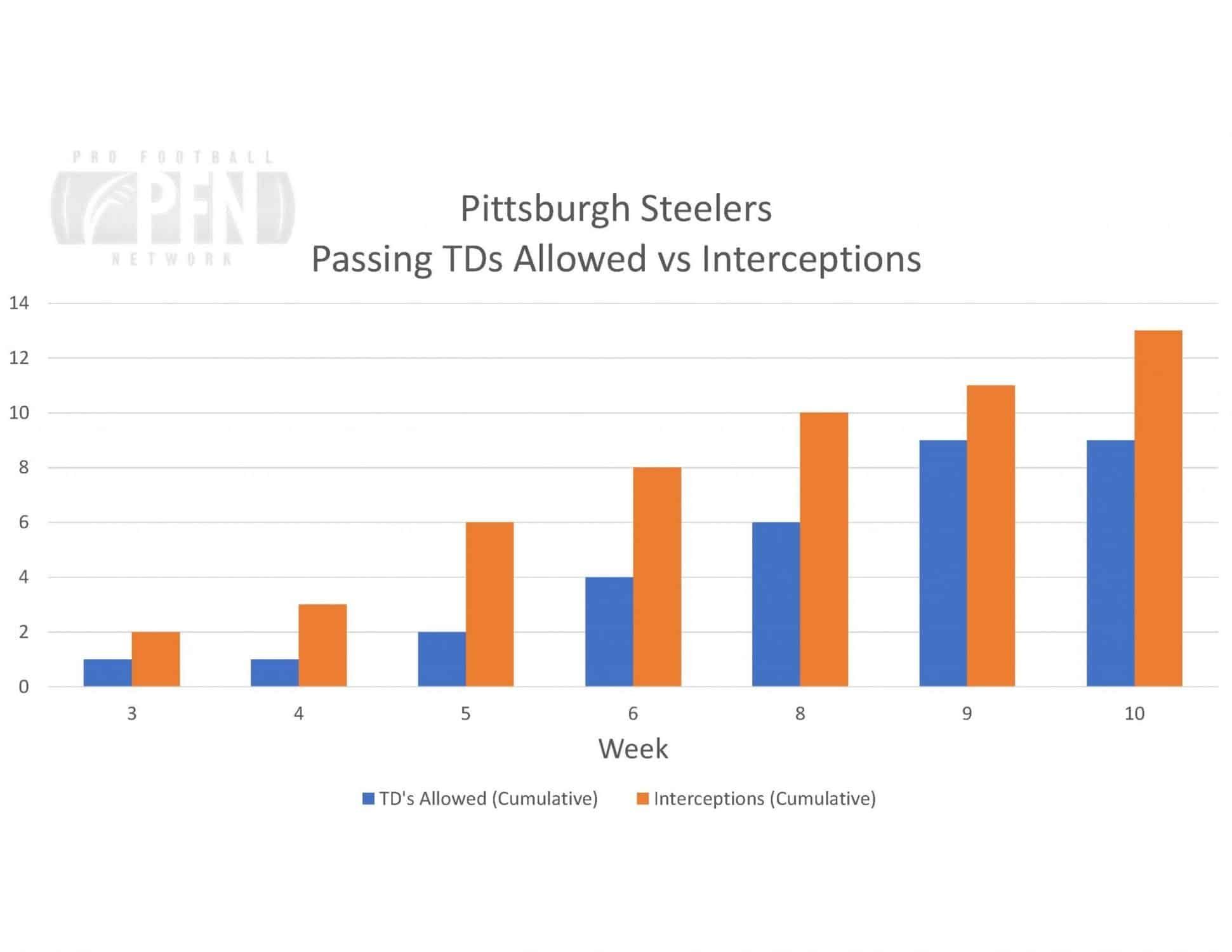 One of the most telling figures for a secondary is completion percentage allowed. The secondary was obviously struggling in Pittsburgh to start the season, allowing nearly 68% completion in Week 1 and 83% completion in Week 2. Making matters worse, the Steelers secondary allowed nearly 10% more completions than expected in Week 2 based on NFL Next Gen Stats.
One of the most telling figures for a secondary is completion percentage allowed. The secondary was obviously struggling in Pittsburgh to start the season, allowing nearly 68% completion in Week 1 and 83% completion in Week 2. Making matters worse, the Steelers secondary allowed nearly 10% more completions than expected in Week 2 based on NFL Next Gen Stats.
It didn’t take long before Fitzpatrick changed that. Look at the weekly completion % allowed vs expected. The completion % has gone down tremendously, never eclipsing 70%. It has also been at, or below, the expected completion % each week. Minkah Fitzpatrick has literally welded the defense back together, producing what could be the second coming of the Steel Curtain in Pittsburgh.
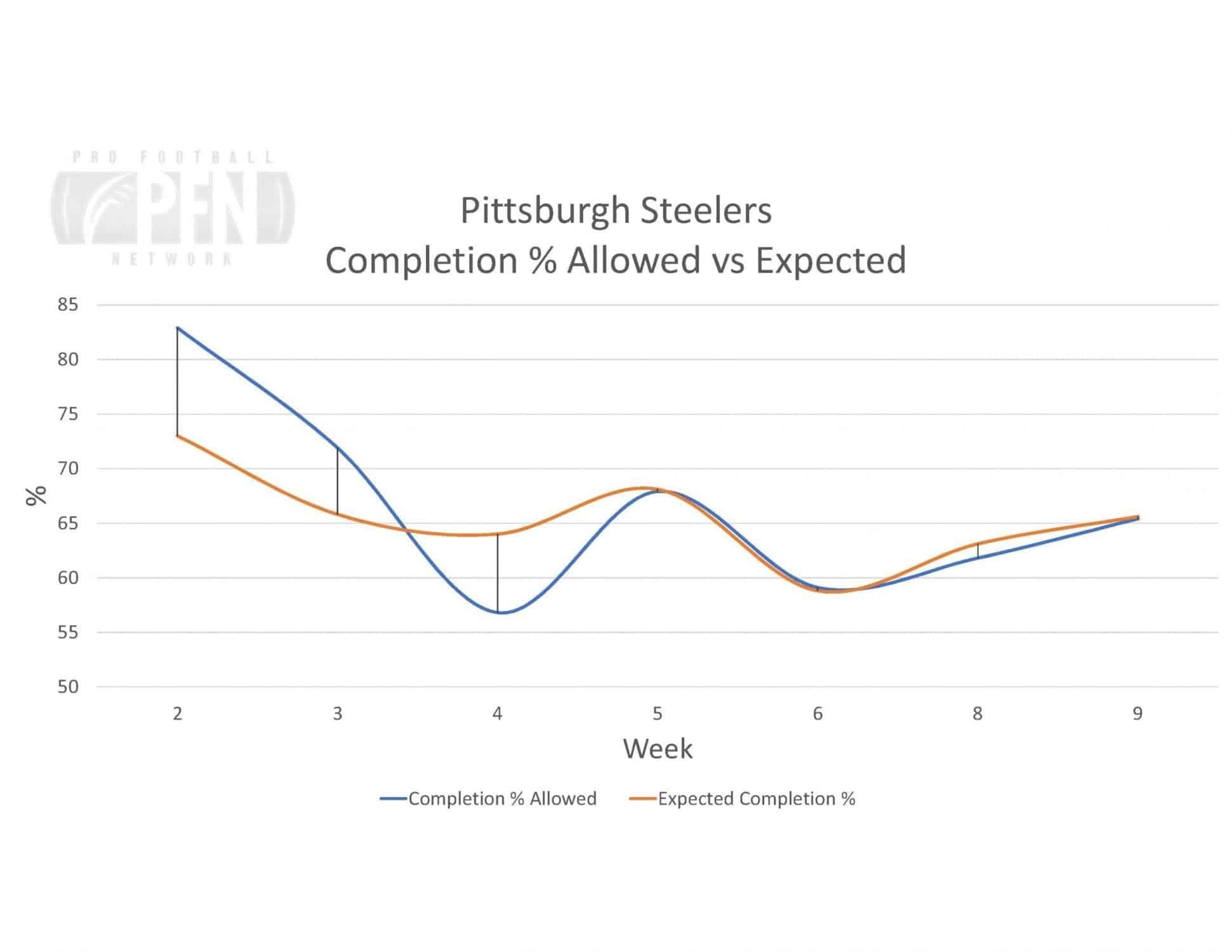 Minkah Fitz-magic
Minkah Fitz-magic
Minkah isn’t some magician wielding his wand to make this team better. But there’s no denying he has magically energized the Steelers defense and saved them from a potentially wasted season. His presence on the field is allowing the entire defense to play better, and to play the way that is expected of them. When you take the talent on the team, paired with Minkah’s influence and ball-hawking skills, this Pittsburgh defense has the potential to be something great.
How fitting is it that a player noted for his preparedness, discipline and work ethic – the complete embodiment of the blue-collar mentality that resonates throughout the Steel City – is quickly becoming the face of one of the NFL’s greatest franchises.
For the latest news and NFL updates, be sure to follow Pro Football Network on Facebook and on Twitter @PFN365.

